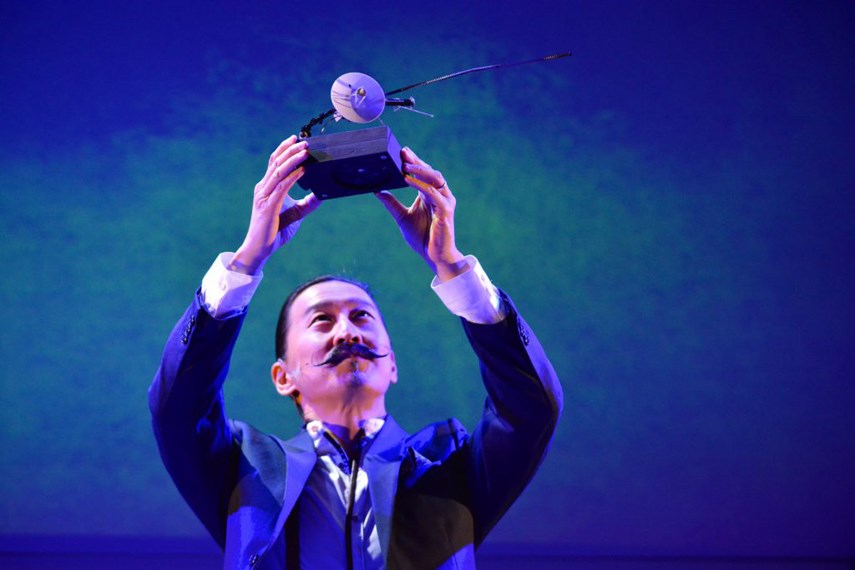1 Hour Photo. Written and performed by Tetsuro Shigematsu. Visit thecultch.com for showtimes.
When actor and playwright Tetsuro Shigematsu moved into a friend’s home, he was struck by some of the everyday items he encountered that made up the remnants of a life lived.
“I found a set of towels that said ‘Japan Camera’ and there was a mug that said ‘Japan Camera.’ And I wondered, ‘What is my friend Donna’s connection to this franchise I can scarcely remember?’” Shigematsu explains.
He soon found the answer in 90-year-old Mas Yamamoto, his friend’s father, who had spent a good portion of his adult life running a one-hour photofinishing company in North Vancouver starting in the early 1980s.
Shigematsu remembers thinking a family-run business, like a photo services store, might make a good setting for his next play. When he got to really talking with Yamamoto and learned more about his life, he realized there was so much more.
“When I began interviewing Mas, it wasn’t very long before I realized there’s a much bigger story to be told,” he says.
Those initial exploratory conversations between Shigematsu and Yamamoto laid the foundation for his new play, 1 Hour Photo, which premiered earlier this week at The Cultch.
The play is the highly anticipated followup to Shigematsu’s 2015 smash hit Empire of the Son, an experimental piece that dealt largely with Shigematsu’s relationship with his father, Akira.
In 1 Hour Photo that story hangs like a spectre over the rest of the production.
“It felt to me like a compulsion,” Shigematsu says. “When my father died there was this sort of deep-seeded psychological need on my part to continue the conversation and somehow keep the ritual going of sitting at the knee of an elder and learning everything that I could about someone’s life.”
Sitting at the knee of Yamamoto, the pair recorded around 36 hours of interviews. What emerges from those conversations, according to Shigematsu, is a captivating narrative of the 20th century from a man who was swept up in many of its major events, for better or worse.
Yamamoto grew up in a fishing village along the banks of the Fraser River. His family was interned along with other Japanese-Canadians during the Second World War. But Yamamoto would still go on to help guard the Canadian Arctic against Soviet bombers during the Cold War as part of the Distant Early Warning Line radar station program.
This year marks the 75th anniversary of the internment of Japanese-Canadians, adding an air of immediacy and timeliness to the story.
“Now with the talk of reconciliation and residential schools that’s beginning to burgeon within public consciousness, and now with the 75th anniversary of the internment, people are beginning to hear a little bit now about what happened,” Shigematsu says.
But while Japanese-Canadian internment looms large in the play, Shigematsu doesn’t want theatregoers to assume it’s solely a historical work.
Instead, he believes what they’ll be most captivated by is “a love story that will take your breath away.”
The play explores a whole host of love stories – between father and son, husband and wife, and even elder and friend, in the case of Shigematsu and Yamamoto.
Shortly after Pearl Harbour, thousands of Japanese-Canadians had their homes seized by the Canadian government and were shipped hundreds of kilometres away, Shigematsu explains. “Despite the circumstances, young love blooms and he falls in love,” he says, explaining how a young Yamamoto meets and falls in love with a woman named Midge while they’re both interned.
“What’s interesting to me as I listen to his life story, it became clear to me that when they said goodbye to each other at Lemon Creek, which was the name of their internment camp, she would continue to be his north star, in a sense.”
But while Yamamoto and Midge kept in touch for a time afterwards, life eventually interceded – Midge happily got married and had a family, as did Yamamoto.
In both a historical and personal sense then, 1 Hour Photo explores memory – about what happens in the past and the lingering sense of what might have been.
The play’s also a technical and multimedia achievement, building off the experiments that Shigematsu and his production team first tried out during the Empire of the Son run. Audiences can expect a barrage of video footage, intricately designed scale models as set pieces, and a combination of live and recorded audio and music.
“The set itself is actually one gigantic photograph,” he says. “Upon that screen, we project all sorts of photographs from Mas’s past, even ones he hasn’t seen before, as well as eight-millimetre footage, which has been an extraordinary find.”
The play takes on a personal note for Shigematsu, who began interviewing Yamamoto for the production a month and a half after his father died.
The parallel storylines between Shigematsu and his father and Shigematsu and Yamamoto overlap and intertwine throughout the play, encouraging the audience to think about what it means to live a good life while contemplating the meaning of what makes a good death.
And memories, much like the photos that were developed at Yamamoto’s one-hour photo store, always hangs in the background.
“All of us, even if we’re in a very happy and committed relationship, each of us has at least one person in our heart that we can’t forget,” Shigematsu says. It will be up to the audience to decide what parts of Shigematsu’s new play are the most unforgettable.



